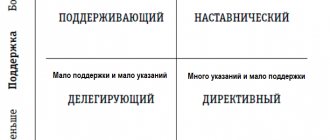Consultation for teachers “Styles of teaching activity”
Elina Agapova
Consultation for teachers “Styles of teaching activity”
«STYLES OF TEACHING ACTIVITY»
One of the factors influencing the development of a child’s personality is the communication style inherent in the teacher. The style of pedagogical activity can be defined as methods of educational influence, manifested in a typical set of requirements and expectations for the appropriate behavior of students. It is embodied in characteristic forms of organizing the activities and communication of children and has appropriate ways of implementing the teacher’s attitude towards the child’s personality , associated with the achieved level of professional pedagogical activity .
The styles of pedagogical activity depend on several factors - both on the activity and on its subjects, that is, students. Style is largely determined by the individual characteristics of the teacher.
In modern pedagogy, the following styles of teaching activity are distinguished:
1. Authoritarian;
2. Democratic;
3. Liberal-permissive.
Authoritarian style of teaching
The teacher considers his students to be objects of influence, and not equal partners in activities . Separates himself both from the educational team and from each child individually.
His main methods of influencing students are teaching, ordering, and such a teacher always controls the fulfillment of his assignments independently and quite strictly, and not always quite correctly. They need complete and unquestioning submission from their students. And they do not consider it necessary to explain the reasons for their orders, prohibitions, restrictions and permissions.
Teachers with an authoritarian style of activity are often emotionally cold; they are strong-willed people with a strong character. At the same time, many people are dissatisfied with their professional activities .
With this style of influence, students suffer. no contact is established with , which worsens the children’s academic performance and their desire to learn new things. Most children lose self-confidence and independence, and displays of aggression are common.
Democratic style of pedagogical activity
This style is simply not possible without the pupils’ love for children, high moral qualities, and professionalism. All this is the key to the successful development of a child’s personality.
Such a teacher is friendly to his students, patient and tolerant; he strives to build subject-subject relationships. Tries to create a business-like and at the same time warm, calm atmosphere. The student is considered as an equal partner in communication, a colleague in the joint search for knowledge. Methods of influence are encouragement to action, advice, request.
Teachers of the democratic style greatly value independence in children ; they resolve many issues with their students, often trusting them to make their own choices and defend their opinions. The teacher involves students in decision-making, takes into account their opinions, encourages independent judgment, takes into account not only academic performance, but also the personal qualities of students. At the same time, we are not talking about indifference: the rights of children are not infringed, but they clearly understand what responsibilities are assigned to them , there is unobtrusive control.
With teachers with a democratic style , schoolchildren more often experience states of calm satisfaction and high self-esteem. Teachers with this style pay more attention to their psychological skills. Such teachers are characterized by greater professional stability and satisfaction with their profession.
Liberal-permissive style of teaching
This is primarily the lack of professionalism and lack of discipline of the teacher . He is indecisive, hesitant, unsure of himself. He transfers the initiative to students and colleagues. Organizes and controls the activities of students without a system, shows indecision and hesitation.
Other styles of teachers' activities . A.K. Markova and A.Ya. Nikonova divided them into four types.
Emotional Improvisational Style (EIS)
Teachers with EIS are distinguished by a predominant focus on the learning process. Such a teacher constructs an explanation of new material in a logical and interesting way, but during the process of explanation he often lacks feedback from the students.
During the survey, the teacher with EIS addresses a large number of students, mostly strong ones, who are of interest to him, interviews them at a fast pace, asks informal questions, but does not allow them to speak much, does not wait for them to formulate an answer on their own.
A teacher with EIS is characterized by insufficiently adequate planning of the teaching and educational process. To practice in class, he chooses the most interesting educational material; Less interesting material, although important, he leaves for students to independently analyze.
In the activities of teachers with EIS, consolidation and repetition of educational material, monitoring of students’ knowledge are not sufficiently represented.
Teachers with EIS are distinguished by high efficiency and the use of a large arsenal of various teaching methods. He often practices collective discussions and stimulates spontaneous statements from students.
Teachers with EIS are characterized by intuitiveness, which is expressed in the frequent inability to analyze the features and effectiveness of their activities in the lesson .
Recommendations
You have many advantages: a high level of knowledge, artistry, contact, insight, the ability to teach educational material in an interesting way, captivate students with the subject being taught, manage team work, and vary a variety of forms and methods of teaching. Your lessons have a favorable psychological climate.
However, your activities are also characterized by certain shortcomings: lack of methodology (insufficient representation in your activities of consolidating and repeating educational material, monitoring students’ knowledge). There may be insufficient attention to the level of knowledge of weak students, insufficient demands, inflated self-esteem, demonstrativeness, increased sensitivity, which causes your excessive dependence on the situation in the lesson.
As a result, your students have a persistent interest in the subject being studied and high cognitive activity combined with fragile knowledge and insufficiently developed learning skills.
Try it
-Slightly reduce the amount of time allocated to explaining new material;
- During the process of explanation, carefully monitor how the material is being absorbed (to do this, at certain intervals you can ask students to repeat what was said or answer questions).
-Never start studying new material without being sure that all students have mastered the previous one.
-Be attentive to the level of knowledge of weak students.
- Carefully practice all educational material, paying great attention to consolidation and repetition. Don't be afraid or avoid the "boring"
types of work - practicing rules, repetition.
-Try to activate students not with external entertainment, but to arouse their interest in the features of the subject itself.
-During the survey, spend more time on each student’s answer, seek the correct answer, never correct mistakes right away: let the person who made a mistake clearly formulate and correct his answer, and you help him with clarifications and additions. Always give a detailed and objective assessment of each answer.
-Increase your demands. Make sure that students answer and complete tests on their own, without prompting or peeping.
-Try to plan the lesson in detail, carry out the planned plan and analyze your activities in the lesson .
Emotional-methodical style (EMS)
A teacher with EMS is characterized by an orientation towards the learning process and results, adequate planning of the teaching and educational process, high efficiency, and a certain predominance of intuitiveness over reflexivity.
Focusing on both the process and the results of learning, such a teacher adequately plans the educational process, gradually works through all educational material, carefully monitors the level of knowledge of all students (both strong and weak; his activities constantly include consolidation and repetition of educational material, control of students' knowledge.
Such a teacher is distinguished by high efficiency, he often changes the types of work in the lesson, and practices collective discussions.
Using the same rich arsenal of methodological techniques when practicing educational material as a teacher with EMS, a teacher with EMS, unlike the latter, strives to activate children not with external entertainment, but to firmly interest them in the features of the subject itself.
Recommendations
You are distinguished by many advantages: a high level of knowledge, contact, insight, high methodology, exactingness, the ability to teach educational material in an interesting way, the ability to activate students, arousing their interest in the features of the subject, skillful use and variation of forms and methods of teaching.
As a result, your students combine solid knowledge with high cognitive activity and formulated student skills.
However, you also have some shortcomings: somewhat inflated self-esteem, some demonstrativeness, increased sensitivity, causing your excessive dependence on the situation in the lesson, the mood and preparedness of the students.
Try:
-Talk less in class, giving your students the opportunity to express themselves fully, do not immediately correct incorrect answers, but through numerous clarifications, additions, and hints, ensure that the respondent himself corrects and formalizes his answer. Offer your own wording only when it is really necessary.
-If possible, try to show more restraint.
Reasoning-improvisational style (RIS)
A teacher with RIS is characterized by an orientation towards the process and results of learning, and adequate planning of the educational process.
Compared to teachers with emotional styles , a teacher with RIS shows less ingenuity in selecting and varying teaching methods, is not always able to ensure a high pace of work, practices collective discussions less often, the relative time of spontaneous speech of his students during lessons is less than in the lessons of teachers with emotional styles. style _
A teacher with RIS speaks less himself, especially during a survey, preferring to influence students indirectly (through hints, clarifications, etc., giving respondents the opportunity to formulate their answer in detail.
Recommendations
You have many advantages: a high level of knowledge, contact, insight, exactingness, the ability to clearly and clearly teach educational material, attentive attitude to the level of knowledge of all students, objective self-esteem, restraint.
Your students' interest in the subject being studied is combined with solid knowledge and developed learning skills.
However, your activities are also characterized by certain shortcomings: insufficiently wide variation in forms and methods of teaching, insufficient attention to the constant maintenance of discipline in the classroom.
You devote a lot of time to each student’s answer, ensure that he forms his answer in detail, and objectively evaluate it, which increases the effectiveness of your activities . At the same time, this manner of conducting a survey causes a somewhat slower pace of the lesson. This disadvantage can be compensated for by making greater use of a variety of working methods.
Try:
-Practice collective discussions more often, be more creative in selecting topics that captivate students.
-Show more intolerance towards violations of discipline in the classroom. Immediately and strictly require silence in every lesson, and in the long run you will not have to make as many disciplinary remarks.
Reasoning-methodical style (RMS)
Focusing primarily on learning outcomes and adequately planning the educational process, a teacher with RMS is conservative in the use of means and methods of teaching .
High methodology (systematic reinforcement, repetition of educational material, control of students’ knowledge) is combined with a small, standard set of teaching methods used, preference for students’ reproductive activity , and rare collective discussions.
During the questioning process, the teacher with RMS addresses a small number of students, giving each a lot of time to answer, devoting special time to weak students. A teacher with RMS is generally characterized by reflexivity.
Recommendations
You have many advantages: highly methodical, attentive to the level of knowledge of all students, and highly demanding.
However, your activities are also characterized by certain shortcomings: the inability to constantly maintain students’ interest in the subject being studied, the use of a standard set of forms and methods of teaching, a preference for reproductive rather than productive activities of students , an unstable emotional attitude towards students.
As a result, your students have developed learning skills and solid knowledge with a lack of interest in the subject being studied. For many of them, attending your lessons is tedious and not always interesting. Your lessons often lack a favorable psychological climate.
Try:
Encourage good answers more widely and condemn bad ones less harshly. After all, the results of their learning ultimately depend on the emotional state of your students.
Try to expand your arsenal of methodological techniques and vary the various forms of classes more widely. If you teach a foreign language, do not limit yourself to reproductive types of work: memorizing texts, memorizing rules. If you use only them, then your students will lose interest in the subject, and most importantly, they will have a weak orientation in the language. Try to use various exercises to activate speech skills: situational dialogues, language games, songs, poems, filmstrips.
If you teach humanities subjects, practice group discussions more often, choose topics for them that can captivate students.
What is pedagogical communication
It is known that unprofessional pedagogical communication creates fear, uncertainty, causes a decrease in performance, impaired speech dynamics, reluctance to think and act independently, alienation, and a persistent negative attitude towards the teacher. The feeling of depression from studying a certain subject (and often from communicating with the teacher) remains in some students for many years.
Professional pedagogical communication presupposes a high culture, which indicates the teacher’s ability to realize his capabilities in choosing a certain style of pedagogical communication.









